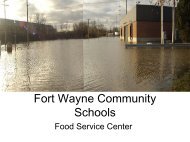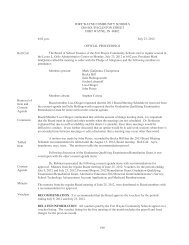Educating a Diverse Population - Fort Wayne Community Schools
Educating a Diverse Population - Fort Wayne Community Schools
Educating a Diverse Population - Fort Wayne Community Schools
You also want an ePaper? Increase the reach of your titles
YUMPU automatically turns print PDFs into web optimized ePapers that Google loves.
<strong>Educating</strong> a <strong>Diverse</strong><br />
<strong>Population</strong><br />
March 14, 2005
FWCS Official Enrollment<br />
1994 vs. 2004<br />
Sept. 1994<br />
Sept. 2004<br />
African-American<br />
American-Indian<br />
Asian<br />
Hispanic<br />
White<br />
Multi-Racial<br />
24.02%<br />
.28%<br />
1.50%<br />
3.22%<br />
70.96%<br />
na<br />
25.83%<br />
.56%<br />
2.26%<br />
9.58%<br />
59.05%<br />
2.73%
Where we were . . .
Evolution of Equity Policies<br />
RELATIVE TIME<br />
PERIOD:<br />
Before 1950’s<br />
Segregation<br />
NATION<br />
SOCIAL POLICY:<br />
MOTIVATION:<br />
Legal Separation<br />
1950’s<br />
Desegregation<br />
Legislated Desegregation<br />
1960’s<br />
1970’s<br />
1980’s<br />
Integration, equal<br />
access, equal rights<br />
Equal benefits,<br />
multiculturalism<br />
Diversity<br />
Activism for social justice<br />
Education<br />
Economic
George Peabody College for Teachers<br />
• A comprehensive evaluation of each major<br />
aspect of school operations (124 recommendations)<br />
• Five alternative plans for achieving greater racial<br />
balance
Chronology of Desegregation of FWCS<br />
1984 The problem…<br />
• Enrollments at 22 of 36 FWCS elementary schools are severely<br />
imbalanced according to the U.S. Dept. of Education’s Office of Civil<br />
Rights (OCR).<br />
• <strong>Community</strong> meetings planned to discuss issue.<br />
1985 Dissention mounts…<br />
• Parents for Quality Education with Integration, Inc. (PQEI) formed.<br />
• Open disagreement between FWCS and proponents of racial balance.<br />
• William L. Taylor, attorney from Washington, D.C., hired by PQEI with<br />
financial backing from Lincoln National Corporation.<br />
1986 Is there an agreeable solution?<br />
• Negotiations begin between PQEI and FWCS.<br />
• Leadership <strong>Fort</strong> <strong>Wayne</strong> brings Dr. Christine Rosell to speak on racial<br />
balance options.<br />
• PQEI works to organize possible litigants.<br />
• Negotiations fail and PQEI files lawsuit.
Chronology of Desegregation of FWCS<br />
1987 Some progress, but not enough…<br />
• Behind-the-scenes discussion continues.<br />
• FWCS approves magnet school plan which provides a settlement with the<br />
OCR.<br />
• PQEI believes plan needs to be more comprehensive.<br />
• Trial date set for October 1988.<br />
1988 Beginning to find common ground…<br />
• Parties agree on 15-45 percent racial balance but differ on need for<br />
educational improvement program.<br />
• Trial rescheduled for 1989.<br />
• Mr. Black, president of Indiana Michigan Power Company, negotiates a<br />
tentative agreement.<br />
1989 Settlement between FWCS and PQEI<br />
• Settlement finalized in February.<br />
• FWCS and PQEI agree to work together to ensure passage of Bill 1131.<br />
• Educational Improvement Committee (EIC) formed.
Chronology of Desegregation of FWCS<br />
1990 Progress continues…<br />
• First meeting of the EIC.<br />
• Positive tone set with former FWCS superintendent, Dr. Bill Coats.<br />
1992 Racial balance achieved…<br />
• All 36 elementary schools are racially balanced.<br />
1994 Settlement with the state finalized…<br />
• $12.3 million dollars for educational improvements provided through the<br />
state settlement. Funds ended July 2000.<br />
2002 Last EIC meeting held.
Educational Improvement Committee<br />
Committee Members:<br />
• Six members from FWCS<br />
• Three members from PQEI<br />
• One member appointed by the Corporate Council<br />
• One member appointed by the Chamber of<br />
Commerce<br />
• Alternates include the following:<br />
• Two appointments by FWCS, one appointment by PQEI, and<br />
one jointly appointed by the Chamber of Commerce and<br />
Corporate Council
Educational Improvement Committee<br />
Purpose:<br />
• To identify, describe, evaluate, determine costs and<br />
to rank in order of priority, according to the<br />
availability of funding, programs and services that are<br />
designed to serve children at risk of educational<br />
failure. This includes:<br />
• Preventive, remedial, supplementary education for children working<br />
below grade level.<br />
• Programs devoted to positive interracial relationships, including inservice<br />
training programs “with particular attention to the needs of<br />
faculty and staff assigned to currently racially isolated schools.”<br />
• To secure other funding sources.<br />
• To prioritize educational improvement programs that<br />
would require additional funding.
EIC Funded Initiatives<br />
• Reading Recovery<br />
• Diversity Training<br />
• Full-day Kindergarten (in non-Magnet schools)<br />
• Conflict Mediation<br />
• Program Evaluations
Where We Are Now
The mission of FWCS:<br />
… is to guarantee that all students are<br />
prepared to lead responsible,<br />
compassionate, productive lives by<br />
ensuring:<br />
• Every student masters a rigorous<br />
curriculum, and<br />
• Every member of the educational<br />
community is valued in a secure, caring<br />
and creative environment.
Belief Statements<br />
1. All people have the right to an education.<br />
2. All people have equal intrinsic worth.<br />
3. A person’s dignity is sacred.<br />
4. Each person has the need to love and be loved.<br />
5. All people have the capacity to achieve.<br />
6. Everyone has the right and responsibility to pursue his or her individual<br />
aspirations.<br />
7. Honesty is essential to relationships.<br />
8. Dynamic and continuous communication is essential to community.<br />
9. Each person is responsible for his or her actions.<br />
10. A work ethic is basic to achievement and self-worth.<br />
11. The diversity of people and ideas enriches the individual and community.<br />
12. Each person has the responsibility to contribute constructively to his or her<br />
community.<br />
13. Adults are responsible for the well-being of children.<br />
14. A family structure is crucial to a sense of belonging.
No Child Left Behind Act<br />
• …“close or dramatically narrow the<br />
differences in achievement among American<br />
students across lines of skin color, ethnicity,<br />
immigrant status, and wealth.”<br />
• …“the success of American democracy and<br />
our economic future depends on a society in<br />
which everyone is educated to their full<br />
potential.”
Implementation of NCLB<br />
1. How to raise the achievement of all<br />
students,<br />
While…<br />
2. Ensuring that all demographic groups<br />
meet the standard set by the law.
NCLB<br />
E/LA (58.8)<br />
Math (57.1)<br />
Attend or<br />
Grad 95%<br />
95% Test in<br />
E/LA<br />
95% Test in<br />
Math<br />
Overall<br />
YES<br />
YES<br />
YES<br />
YES<br />
YES<br />
IEP<br />
YES<br />
YES<br />
YES<br />
YES<br />
LEP<br />
NO<br />
YES<br />
YES<br />
YES<br />
Econ Dis<br />
NO<br />
NO<br />
YES<br />
YES<br />
A Indian<br />
YES<br />
YES<br />
YES<br />
YES<br />
Black<br />
NO<br />
NO<br />
YES<br />
YES<br />
Asian<br />
YES<br />
YES<br />
YES<br />
YES<br />
Hispanic<br />
YES<br />
YES<br />
YES<br />
YES<br />
White<br />
YES<br />
YES<br />
YES<br />
YES
Cultural Competency<br />
IC 20-10.2-2-3.8 Sec. 3.8<br />
• “…a system of congruent behaviors, attitudes,<br />
and policies that enables Teachers to work<br />
effectively in cross-cultural situations. The term<br />
includes the use of knowledge concerning<br />
individuals and groups to develop specific<br />
standards, policies, practices, and attitudes to be<br />
used in appropriate cultural settings to increase<br />
students’ educational performance.”
Cultural Competency component<br />
of school plan<br />
IC 20-10.2-8-3 Sec.3<br />
• (a) In developing a school’s strategic and continuous school<br />
improvement and achievement plan under IC 20-10.2-3, the school’s<br />
committee shall consider methods to improve the cultural competency<br />
of the school’s teachers, administrators, staff, parents, and students.<br />
• (b) The committee shall:<br />
• (1) identify the racial, ethnic, language-minority, cultural, exceptional<br />
learning, and socioeconomic groups that are included in the school’s<br />
student population;<br />
• (2) Incorporate culturally appropriate strategies for increasing educational<br />
opportunities and educational performance for each group in the school’s<br />
plan; and<br />
• (3) Recommend areas in which additional professional development is<br />
necessary to increase cultural competency in the school’s education<br />
environment.<br />
• (c) The committee shall update annually the information identified<br />
under subsection (b) (1).
“When professionals are ‘culturally<br />
competent’, they establish positive<br />
helping relationships, engage the client<br />
(students) and improve the quality of<br />
service (education) they provide.”<br />
- Roger Cleveland
Cultural Proficiency definition<br />
“The policies and practices of<br />
organizations and the values and<br />
behaviors of individuals that enable<br />
both to interact effectively in a<br />
culturally diverse environment.”
Cultural Proficiency model<br />
• Guiding Principles – underlying values of the<br />
approach<br />
• Culture is a predominant force; you cannot NOT be<br />
influenced by culture.<br />
• People are served in varying degrees by the dominant<br />
culture.<br />
• It is important to acknowledge the group identity of<br />
individuals.<br />
• Diversity within cultures is important; cultural groups<br />
are neither homogeneous nor monolithic.<br />
• Respect the unique cultural needs that members of<br />
dominated groups may have.
Cultural Proficiency model<br />
• Essential Elements – Behavioral standards<br />
(competencies) for measuring and planning for<br />
growth toward cultural proficiency<br />
• Assess Culture: Name the Differences<br />
• Value Diversity: Claim Your Differences<br />
• Manage the Dynamics of Difference: Reframe the<br />
Conflict Caused by Differences<br />
• Adapt to Diversity: Change to Make a Difference<br />
• Institutionalize Cultural Knowledge: Train About<br />
Differences
Cultural Proficiency model<br />
• A Continuum – Language for describing both<br />
healthy and non-productive policies, practices, and<br />
individual behaviors.<br />
• Cultural Destructiveness: See the Difference, Stomp<br />
It Out<br />
• Cultural Incapacity: See the Difference, Make It Wrong<br />
• Cultural Blindness: See the Difference, Act Like You Don’t<br />
• Cultural Precompetence: See the Difference, Respond to<br />
It Inappropriately<br />
• Cultural Competence: See the Difference, Understand the<br />
Difference That Difference Makes<br />
• Cultural Proficiency: See the Differences and Respond<br />
Positively and Affirmingly
“You can’t have an island of<br />
educational excellence in a sea of<br />
community indifference”<br />
- Ernest Boyer














